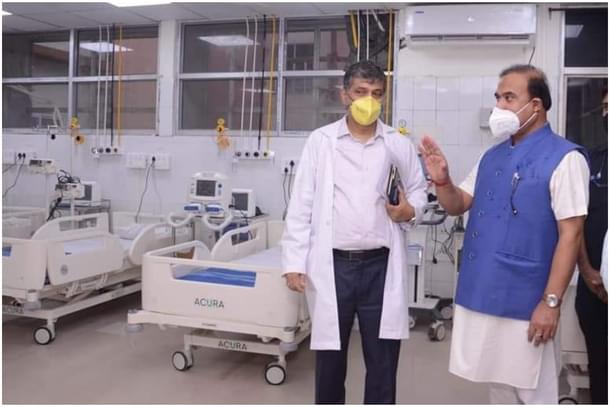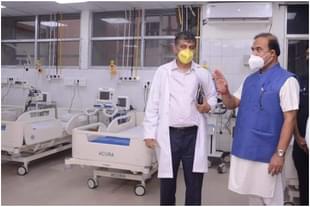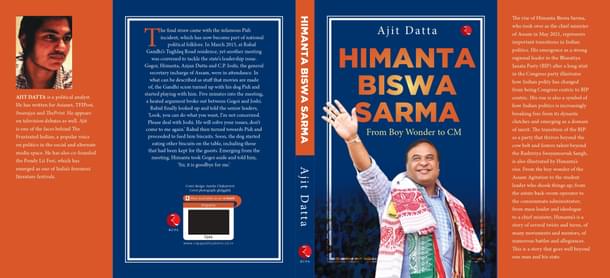Books
Book Excerpt: How Himanta Biswa Sarma Transformed Assam’s Healthcare System
Ajit Datta
Feb 26, 2022, 06:23 PM | Updated 06:23 PM IST
Save & read from anywhere!
Bookmark stories for easy access on any device or the Swarajya app.


Himanta Biswa Sarma: From Boy Wonder To CM. Ajit Datta. Rupa Publications India. Pages 228. Rs 468.
Meanwhile, Himanta was promoted to a Cabinet rank minister after the 2006 elections. He was awarded the coveted health portfolio, which, however, was like a crown of thorns. Like many other backward states, Assam’s healthcare system was in a shambles when he took over. Not only was it under-capacitated and ill-equipped, but the state’s unusual terrain prevented it from reaching every corner. Back then, India was close to touching the World Health Organization’s mandated doctor to population ratio of 1:1,000, while Assam lagged behind at 1:1,800. The state had only three medical colleges, and fared poorly on several indices. Maternal mortality rates, infant mortality rates and neonatal mortality rates were among the worst in the country. Only 22 percent of the deliveries were institutional, meaning they took place at medical institutions under the supervision of trained personnel. The under-five mortality rate stood at over 100 per 1,000 live births in some districts. Not every district had a district hospital, and several sections of the population such as tea-garden workers lived under terrible health conditions. Moreover, due to a combination of neglect, genetic factors and social practices, several congenital diseases and malformations remained prevalent. Himanta held the ministry for three terms, twice under Gogoi and once under Sonowal with a short hiatus of a few months in between. The transformation that the state’s healthcare witnessed under him is one of independent India’s administrative success stories that is hardly touched upon.
From the very beginning, Himanta had a blueprint to turn things around. He was clear about the broad objectives towards which he needed to work. These included enhancing both human and infrastructural capacity, increasing accessibility and targeting specific ailments. To address the shortfall in medical personnel, new colleges and faculty would be required. Himanta immediately began to work on several new medical colleges across the state. The location of these colleges was strategically placed, both with an aim to give local medical students a chance and to help local patients in the area. For instance, the new Diphu Medical College is in a hilly region that was earlier deprived of quality medical care. When Himanta took over, the state had medical colleges in Guwahati, Dibrugarh and Silchar. By 2020, medical colleges in Jorhat, Tezpur, Barpeta and Diphu were fully functional. The state had only one nursing college when he took over, but by 2020, the new ones at Dibrugarh and Silchar had taken the tally to three. Two dental colleges were also established during his tenure. Many more such colleges continue to be at different stages of construction and approval. When Himanta initially conceived these colleges, he was at the receiving end of a vicious media campaign. The media leveled the accusation that the minister was out to make new colleges when the existing ones were not functioning appropriately. Himanta however brushed this aside and carried on.

Arranging for additional faculty was a huge challenge. The state was already short of faculty, so several plans were devised to reverse this trend. The faculty’s retirement age was raised, first from 58 years to 60 years, and later from 60 years to 65 years. This gave Assam the ability to retain them for longer, and it became an incentive for faculty to work there. In Diphu, the faculty could be retained up to the age of 70, and was given several other perks. Salaries were raised across the board, and senior bureaucrats were sent all over the country to personally convince Assamese faculty working elsewhere to return to the state. One of the milestones in the state’s healthcare journey was when GMC started offering super-specialty courses. Not only was it a first for the entire North-East, but people with various complicated and critical conditions no longer needed to go outside the region for treatment. Medical studies in the state were also streamlined. Earlier, every medical college was affiliated to a different university and followed three different standards. Since 2009, they have all been brought under the ambit of a new university with common exams and question papers. In a few years, these efforts began to bear fruit. Many local medical students who would earlier be forced to study outside Assam now get a chance to stay back, and many end up practicing in the state.
Building a medical college is probably the easiest part of the operation. Getting it up and running is where the real challenge lies. The equipment and machinery must be in place, the faculty must be hired, and only then, after a few rounds of inspections by the Medical Council of India (MCI) and many months of wait, does the college actually begin functioning. Himanta though stands alongside the bureaucrats on every step of the way. One of the bureaucrats who has worked with him closely in establishing these colleges is Dr Manoj Choudhury.
Dr Choudhury recalls how three months before the MCI was to inspect the new medical college at Diphu, he was deputed by Himanta to go and check on the project. They had been informed earlier that the construction and hiring were complete. But upon arriving there, the sight that met his eyes left him aghast. It was an empty construction site with just a skeletal structure. To add to his woes, the ground floor was flooded. Choudhury dialed Himanta and gave him an update. Himanta did not beat around the bush. He simply asked, ‘Manoj, can it be done?’ Choudhury knew it was nearly impossible, but he also knew it was now or never. The college had been supposedly under construction for almost a decade, and the MCI had finally agreed to inspect it. He also knew that if Himanta put his mind to it, no force on earth could stop it from happening. So, he assured Himanta that with his support, it could indeed be pulled off. Choudhury was asked to stay put in Diphu. The next morning, contractors from different parts of the state arrived. They were working on different phases in various upcoming medical colleges and had been asked to stop work temporarily and head to Diphu. Upon their arrival, they found that each of them had been allocated specific tasks along with deadlines. They worked like clockwork day and night, sometimes competing with each other, and often pressurizing one another to complete a step in the sequence so that they could proceed with their own task. Meanwhile, Choudhury worked alongside them. He had to establish the library, create a blood bank, procure beds, machinery and IT equipment. He had to complete the hiring as well. Finally, when the inspection actually happened, it seemed like they had been ready for months.
The National Health Mission, known earlier as the National Rural Health Mission, came about in 2005. It had three primary objectives: lowering infant mortality, lowering maternal mortality and population control. It had other objectives as well, such as controlling various epidemics. When Himanta took over as health minister the following year, he decided to take full advantage of this central government initiative. Work began on 200-bed district hospitals in six districts which didn’t have even one. Eleven new sub-divisional civil hospitals were constructed. These hospitals were fitted with CT scan machines, X-Ray machines and lab equipment. Fifty-seven different kinds of lab tests, X-Rays and CT scans are now conducted without any charges, making diagnosis almost free throughout the state. Moreover, the construction of various kinds of health centres across the state began on a war footing. The number of community health centres nearly doubled. Primary health centres, just over 600 in number when the mission began, crossed the 1,000 figure. Twenty eight special newborn care units were constructed, while newborn care corners came up by the hundreds. By 2020, the newborn care corners had crossed the 900 mark. By 2020, over 90 per cent of child deliveries were institutional, up from just 22 per cent when Himanta took over. Maternal mortality rate has plummeted, from 480 per lakh when he took over to 229 per lakh in 2020. Infant mortality has plummeted as well, from 68 per thousand live births to 44 per thousand in 2020.
The various health centres have proven to be a boon. Unlike other states, it wasn’t enough to have a district hospital covering the entire district, because in some cases, it took over five hours for people from the farthest corners of the district to reach the hospital. But these health centres were not enough. Due to the swelling of rivers, some villages were only accessible by boat for a few months every year. For these villages, Himanta initiated fully equipped boat clinics to provide primary healthcare in 2008. By 2020, 15 such boat clinics were in operation, and had conducted over 23,000 health camps. Similarly, one of the communities which had almost no access to healthcare was the tea-garden community. For them, 80 mobile medical units were created, offering complete primary care. These units cover 445 tea gardens amongst themselves by camping for three or four days in every garden. Fifty such mobile medical units were also created for other parts of the state.





